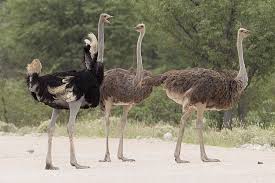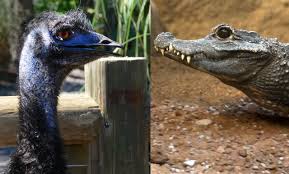The reptiles are a smaller, but very important class of land animals. Reptiles are covered with scales, not hair and most of them lay eggs. The young can fend for themselves as soon as they hatch and seldom receive any parental care. Reptiles are “cold-blooded” animals since their body temperature changes with that of the environment, air or water in which
they live.
Although some reptiles (the crocodiles and some snakes) live in water, they must always come to land to lay their eggs. Snakes are generally considered to be deadly animals to be killed at sight. This fear is unfortunate since many snakes are in fact not poisonous. Sometimes legless lizards are mistaken for snakes.
1. Nile Monitor Lizard (Varanus niloticus)

The Nile monitor lizard is the largest of all African lizards. It has a characteristic stout body, powerful limbs with sharply clawed feet, and long tail flattened for swimming.
It is a largely aquatic reptile which spends the early hours of each day basking in the sun, and only after attaining optimal body temperature does it go hunting for food, It feeds on crabs, frogs, fish, smaller reptiles and birds. It has preference for reptile eggs and will excavate the nests of crocodiles where feasible. It also feeds on carrion and smaller prey may be swallowed whole.
2. Nile Crocodile (Crocodilus niloticus)
Crocodiles are members of the family Crocodylidae. Crocodiles, the largest African reptile, are common in rivers. Where prey is abundant, crocodiles can attain a length of up to 6m and when fully grown can weigh up to 990kg.
It has powerful feet and claws to clamber up the riverbank with surprising speed. The female also uses her claws to dig a nest hole for her eggs. The muscular tail propels and steers the crocodile through water. It is a weapon too: one whop-like blow can knock even a large animal to the ground. The nostrils set on a raised part of the snout, enable the crocodile to breathe when the rest of its body is submerged.
A flap seals the nostrils to keep out water during dives. The eyes, like the nostrils, project above the head, so that the crocodile can keep a lookout for prey while almost fully submerged in the water. Crocodile is one of Africa’s most fearsome predators.
With its massive jaws, the Nile crocodile poses a deadly threat to other animals as it lurks beneath the surface of the water, waiting to snap them up. The simple teeth rip huge chunks out of prey. The teeth grow continuously, and after about two years the worn teeth are forced out by sharp new ones beneath them.
The crocodile cannot chew its food due to its long stabbing teeth that lack cutting or grinding edges and again it has no tongue with which it could manipulate the food in the mouth cavity. Instead, it simply rips chunks off the carcass and swallows them whole. If the animal is too large to be consumed immediately, the remainder is stored underwater, or edged between rocks or submerged wood.
Unlike mammals and birds, reptiles are unable to regulate their body temperature internally. Therefore, crocodiles generally spend each morning basking in the sun to raise the body temperature. As the ambient temperature rises during the day the crocodile opens its month
to let heat escape and may also look for shade or dive into the water where it is cooler. Crocodiles produce 25-100 young at the end of gestation period of 95-100 days. The young reach sexual maturity in 7-15 years.
3. Bush Fowl (Francolinus bicalcaratus)
The bush fowl belongs to the family Phasianidae. It is also known as francolin. There are about 12 different species of francolin in West Africa but this species is the only one that is common or widespread. It has brownish plumage but a closer look reveals a beautiful patterning of the feathers, those of the under parts with markings that are distinctive for this species. There are usually two spurs above the hind toe of old males. It is distributed throughout West Africa except in thickly forested parts.
These ground living birds spend most of their time moving in small parties through grass, farms and the like in search of food. If disturbed they take to the wing with a whirring low flight, often calling hoarsely at the same time. Breeding occurs in the dry season when five to six eggs are laid in a natural hollow in the ground.
4. Ostrich (Struthio cainelus)

The Ostrich is a member of the order Ratities (consisting of flightless birds) and the only living representatives of the sub-order Struthiotes, family Struthionidae. They are endemic to Africa, but occur in captivity in many countries of the World. It is valued for its feathers, meat, leathers as well as a tourist attraction.
The Ostrich is the largest living bird, with the male attaining heights up to 3m and weighing more than 150kg. The head and about two-thirds ofthe long neck are covered with short, hair-like degenerate feathers (filoplume) making the head and neck appear naked.
The East African male ostrich has a red or pink neck, while the South African male ostrich has a blue neck resulting from the presence of male hormone, testosterone, and the prevalent environmental conditions.
The male ostrich has black body feathers, and white wing and tail feathers called rectrices, while the female has a dull brown colouration. This sexual dimorphism is on account of the presence or otherwise of oestrogen (a female hormone). Not all the bones of the skeleton of the Ostrich is hollow, the lower legs have a thick cortex, thus making the bird to be heavy.
In fact too heavy to fly but can run very fast, thus facilitating escape from enemies. With their
powerful legs they can maintain speeds of up to 70km/h and deliver a kick that can injure a lion. They posses two toes (a strongly clawed 3rd digit and a weaker, smaller, clawless 4th digit). The 1st and 2nd digits are absent.
Ostriches have good eyesight and hearing. They have huge eyes relative to body size. The Ostrich has the largest eye of any land animal (albeit relative to body size) even larger than that of the elephant, and it is perfect for spotting danger in the open grassland where they live.
The Ostrich reaches sexual maturity after two years, the females attaining maturity earlier than the males. The cock generally lives and mates with a “head hen” and 2 “auxilliary hens”. The hens lay eggs (numbering between 8 and 14) in the nest built by the cock while only the head hen and the cock incubate the eggs in turn and raise the chicks. The cock incubates the eggs from late afternoon till early morning while the hen takes its turn during the day.
The egg of the ostrich is the largest egg of any living bird, weighing 1 to1.78kg, measuring between 12cm by 10cm and 16cm by 12cm, and has a volume equal to that of 24 hen’s eggs! The egg is creamy white in colour and has a tough shell with an average thickness of 1.97mm.
Ostriches are primarily grazers, but often supplement their diet with succulent fruits, insects and lizards. They are gregarious, gathering into large flocks of up to 600 birds.
Read Also: Order Lagomorpha: Species, Characteristics and their Economic Importance

